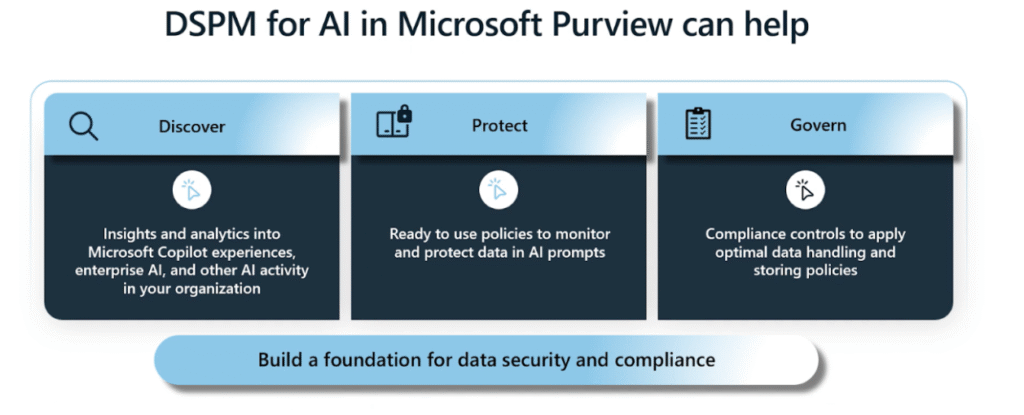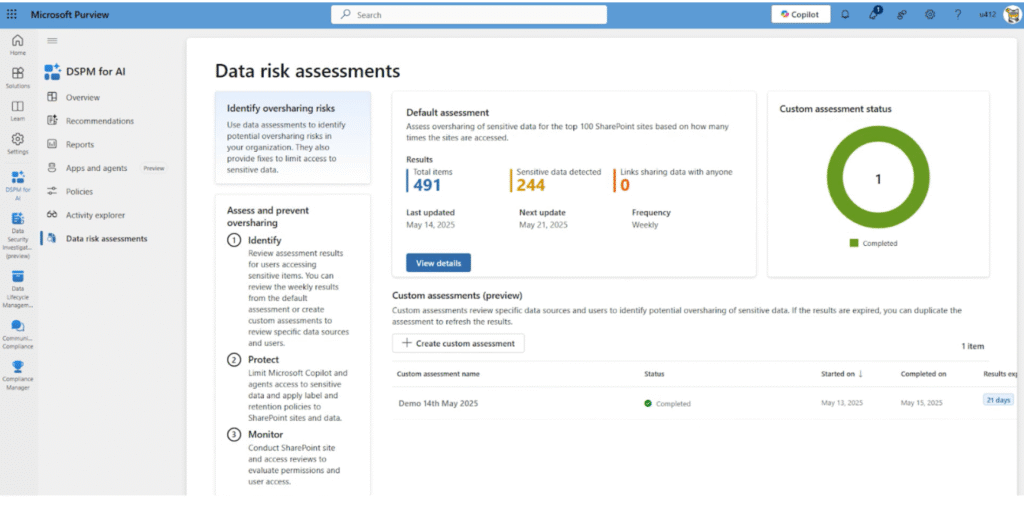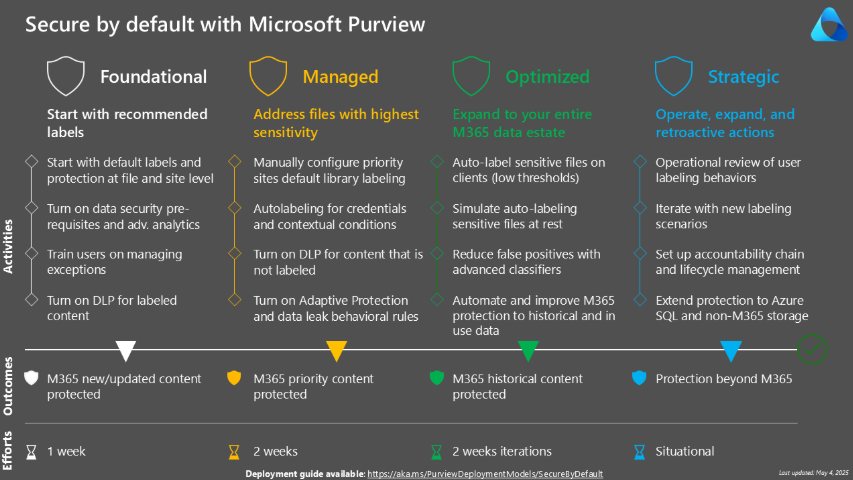Governance Gets an AI Upgrade
In the last twelve months, I’ve seen nearly every enterprise I work with make the leap into AI — copilots automating workflows, generative assistants reshaping operations, and autonomous agents rethinking decision-making itself.
But amid this transformation, one question has echoed in every boardroom:
“Do we still know where our sensitive data goes once AI starts to learn from it?”
That question now defines the security agenda of this decade.
At the Microsoft Fabric Community Conference 2025, Microsoft answered it decisively with the launch of Microsoft Purview Data Security Posture Management (DSPM) for AI — a new command center built directly into the Microsoft Purview portal.
It enables enterprises to discover, protect, and govern data flowing through copilots, third-party AI platforms, and internal LLMs — all from one intelligent interface.
This isn’t just another compliance tool. It’s a paradigm shift — a convergence of data governance and AI security that transforms how enterprises build trust in the age of intelligence.
The Launch in Context — From Governance to Guardrails
Microsoft Purview DSPM for AI marks a shift from static compliance to dynamic protection.
Where traditional frameworks focused on after-the-fact reporting, DSPM enables real-time visibility and control over how AI interacts with enterprise data.
Think of it as a unified command plane — where visibility, control, and compliance converge into a single, adaptive experience.
Key Capabilities that Define DSPM for AI
- Centralized Oversight: Gain a consolidated view of all AI interactions — copilots, agents, or large language models — and how they access, summarize, or generate from enterprise data.
- Ready-to-Use Policies: Deploy one-click configurations to apply labeling standards, enforce DLP rules, and prevent sensitive data from being processed by AI.
- Continuous Risk Assessment: Automated posture checks identify overshared content, risky sites, or data exposure before it becomes an incident.
- Compliance by Design: Native integration with Purview Compliance Manager, Information Protection, and Data Lifecycle Management keeps data usage aligned with corporate and regulatory mandates.
In essence, DSPM for AI is governance turned operational — intelligent, real-time, and inseparable from innovation.
“Governance used to mean oversight. Today, it means orchestration.” — Gaurav Agarwaal
How DSPM for AI Works — From Activation to Action
What makes this launch so elegant is its simplicity.
Within the Microsoft Purview portal, organizations can navigate to:
Solutions → Data Security Posture Management for AI
Once activated, DSPM immediately starts collecting insights across your tenant. Within 24 hours, the dashboard reveals:
- Which users are engaging copilots or AI assistants.
- Which data sources they’re touching.
- Whether sensitive content is being exposed or summarized.
- Where security or governance gaps exist.
The platform automatically runs weekly data risk assessments across your top 100 SharePoint sites — ranking them by usage, content sensitivity, and access control.
Admins can then configure custom assessments to monitor specific user groups, sites, or workloads — transforming AI governance from a passive report into a living posture.
No external connectors, no manual configuration — just insight at machine speed.
The Insights Dashboard — Intelligence in a Single Pane
The Overview dashboard is where strategy meets clarity.
It offers a panoramic “AI posture snapshot” that aggregates activity across Copilot, ChatGPT Enterprise, Gemini, and other AI platforms.
You’ll find:
- AI app summaries that reveal how copilots and AI services are interacting with data.
- Quick-start flyouts for enabling auditing, browser integration, and device onboarding.
- Intelligent recommendations guiding you to secure labeling, DLP, and retention strategies.
- Activity trend reports showing shifts in data exposure, usage volume, and sensitivity mapping over time.
Each insight isn’t a static alert — it’s a contextual recommendation that links directly to remediation actions inside Purview.
Intelligent Recommendations — Awareness That Leads to Prevention
The Recommendations view in DSPM for AI functions as a guided playbook for proactive defense.
It surfaces actionable insights such as:
- “Protect your data from oversharing risks.”
- “Publish default sensitivity labels.”
- “Restrict Copilot from summarizing labeled content.”
- “Detect risky prompts and responses.”
- “Discover and govern ChatGPT Enterprise interactions.”
Each recommendation connects directly to the right Microsoft Purview module — whether that’s Data Loss Prevention, Information Protection, or Data Lifecycle Management — ensuring that discovery, action, and compliance all occur in one ecosystem.
“Microsoft isn’t just surfacing risk — it’s teaching organizations how to solve it.”
— Gaurav Agarwaal
Activity Explorer — Transparency at AI Scale
Traditional security tools generate logs.
AI governance requires explainability — a narrative of who did what, when, and why.
The Activity Explorer delivers this at scale. It captures:
- The user initiating the AI interaction.
- The prompt or command used.
- The data source or file referenced.
- The AI app or agent executing the request.
Each Copilot interaction — from Microsoft 365 to Fabric — is logged with complete context: user identity, timestamp, sensitivity label, and data location.
Prompts and responses are visible when permissions allow, ensuring a full audit trail that supports accountability and regulatory transparency.
“Transparency isn’t about exposure — it’s about understanding intent.”
— Gaurav Agarwaal
Data Risk Assessments — From Audit to Action
The Data Risk Assessment engine is DSPM’s most strategic component.
It unifies automation, analytics, and remediation into a single, workflow-driven experience.
By default, DSPM runs weekly assessments across your most active SharePoint environments, automatically identifying:
- Sensitive files shared broadly.
- Sites with open links (“shared with anyone”).
- Unlabeled or misclassified data.
- Risky user behaviors or access drifts.
Admins can drill down using the four-tab workflow — Overview, Identify, Protect, Monitor — to trace data lineage, enforce protection, or launch access reviews directly from the dashboard.
This converts compliance monitoring into a live, corrective governance process, not a retrospective audit.
Extending Protection Beyond Microsoft 365
AI doesn’t stay within one vendor’s boundary — and neither does DSPM.
It extends protection to:
- Third-party AI platforms such as ChatGPT Enterprise and Gemini.
- Azure AI apps built in-house or by partners.
- Entra-registered AI agents using compliance connectors.
- Browser-based AI activity, through network DLP integration that identifies sensitive content before it’s shared externally.
The result: a consistent, policy-driven protection fabric that follows your data — wherever AI operates.
Leadership Lens — Why This Launch Matters
For CIOs, CISOs, and Chief Data Officers, DSPM for AI bridges three strategic imperatives:
- Visibility You Can Trust
AI activity is no longer invisible — every prompt, response, and model output is observable. - Control That Scales
Policies now travel with your data across copilots, AI agents, and ecosystems. - Compliance That’s Continuous
DSPM automates adherence to frameworks like GDPR, HIPAA, and the EU AI Act — replacing annual audits with continuous assurance.
In short, Microsoft has productized responsible AI governance — operationalizing what used to be aspirational.
My Take — The Right Product at the Right Time
As someone who has lived in the intersection of data architecture, AI, and governance, I can say this confidently:
DSPM for AI is the most relevant security innovation of the AI era.
For years, AI adoption outpaced the safeguards meant to protect it.
With DSPM, Microsoft has closed that gap — offering enterprises the ability to govern what they innovate.
It’s built for hybrid ecosystems where data, models, and people continuously interact.
It’s practical, timely, and engineered for the AI-first enterprise.
What CXOs Should Do Next (Prescriptive)
- Sign in to Microsoft Purview → Solutions → DSPM for AI.
- Enable one-click data protection policies.
- Wait 24 hours for the first insight wave.
- Review Recommendations and remediate high-risk data flows.
- Schedule weekly risk assessments for copilots and critical workspaces.
- Integrate DSPM telemetry into your broader SIEM or Defender dashboards.
In less than a day, organizations can shift from blind AI exposure to measurable AI governance.
Closing Reflection — From Data Security to Data Stewardship
Every technological era demands a new form of stewardship.
In the AI era, that stewardship means not just knowing where your data is, but understanding how your intelligence behaves.
Microsoft Purview DSPM for AI is a bold step toward that reality — an ecosystem where data and AI coexist safely, transparently, and responsibly.
“The enterprises that thrive in the AI age will treat data governance not as compliance — but as a core leadership discipline.”
— Gaurav Agarwaal
Because in an age of autonomous intelligence, the strongest defense is deliberate governance.
Views: 2.8K


Your writing is not only informative but also incredibly inspiring. You have a knack for sparking curiosity and encouraging critical thinking. Thank you for being such a positive influence!
Simply wish to say your article is as amazing The clearness in your post is just nice and i could assume youre an expert on this subject Well with your permission let me to grab your feed to keep updated with forthcoming post Thanks a million and please carry on the gratifying work